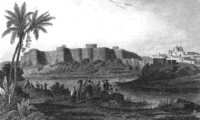Pacco Qillo
Etymology
The fort is known as Pakko Qillo (Sindhi) and Pacco Qillo (English), Pakko means strong, intact and Qillo means fort.
Construction
The Fort was constructed on the hillock known locally as Ganjo Takkar or Ganji, by Mian Ghulam Shah Kalhoro, around 1768 when he founded the city of Hyderabad.
History
During Talpur rule over Sindh, Mir Fateh Ali Khan left Khudabad and moved his capital to Hyderabad in 1789. He used the Hyderabad Fort as a residence and a place in which to hold his court. He added a harem and other buildings to accommodate the ruling family. To enable residents to fulfill their religious obligations, he commissioned the construction of mosques. During this period, the fort was surrounded by working-class homes. After defeating the Mirs in the Battle of Miani in 1843, the British occupied the fort. Blasts in the fort, later on, destroyed most of the architecture and houses of the public. In 1857, the British razed the remaining edifice to make room for military installation and stores.
Gallery
-
Pacco Qillo Boundary wall
-
Gate of Pacco Qillo
-
View of the fort in 1845
-
Shops below Pacco Quillo
See also
- List of forts in Pakistan
- List of cultural heritage sites in Sindh
- List of cultural heritage sites in Pakistan
References
- ^ Owais Akram Rehmani (25 October 2022). "حیدر آباد کا پکا قلعہ تاریخ کے اوراق میں گم ہونے لگا". Independent Urdu (in Urdu). Retrieved 24 December 2024.
- ^ Ahmed, Syed Zeeshan (19 November 2014). "Crumbling majesty: The fascinating Pakka Qila". DAWN.COM.
- ^ Ahmed, Syed Zeeshan (30 June 2015). "A photowalk through historic Hyderabad". DAWN.COM. Retrieved 20 December 2024.
- ^ "Tales of glory and destruction | Footloose | thenews.com.pk". The News International.
- ^ Ahmed, Syed Zeeshan (19 November 2014). "Crumbling majesty: The fascinating Pakka Qila". DAWN.COM. Retrieved 20 December 2024.





